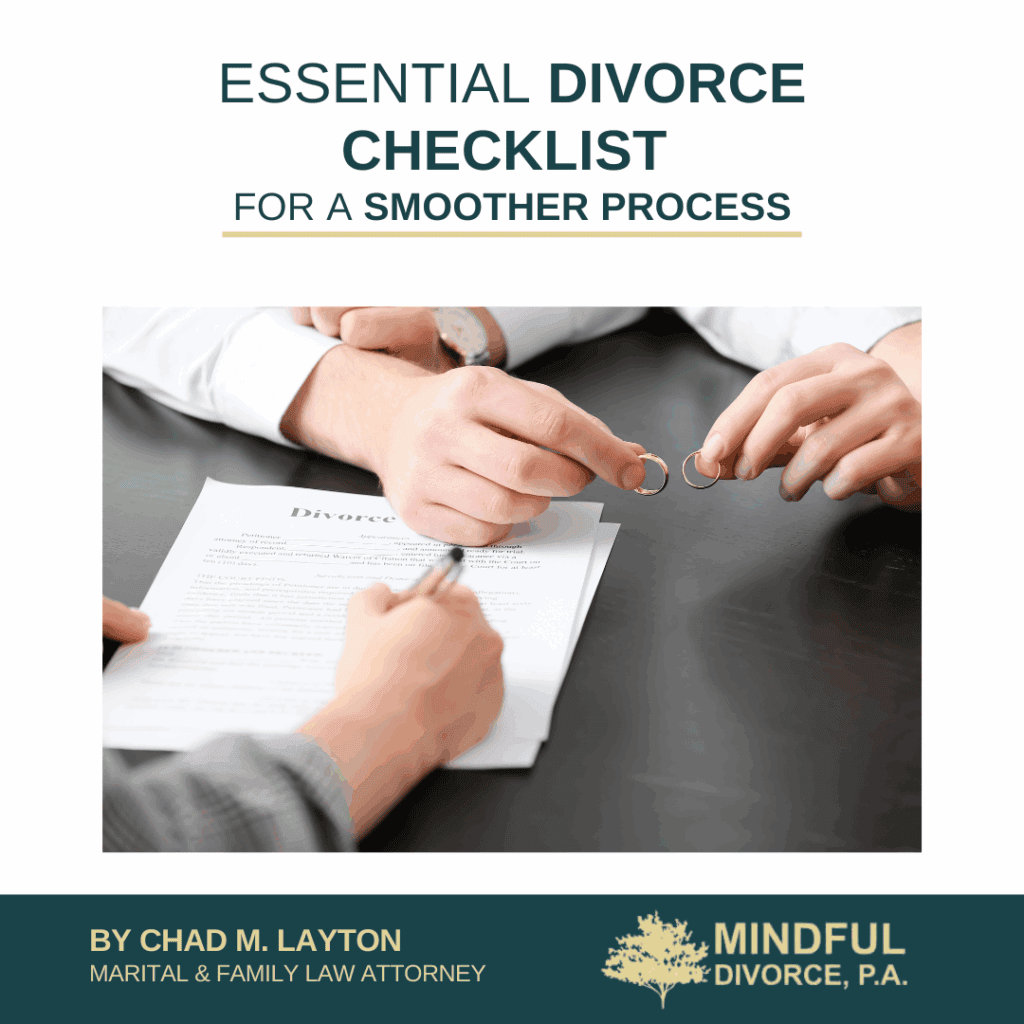
Thinking about divorce can feel like standing at the edge of the unknown. Emotions run high, bills still need paying, and the future seems foggy.
At Mindful Divorce, P.A., we bring clarity through transparent, fixed-fee services so the money talk does not add extra stress. The checklist below sheds light on what needs to happen next, giving you a practical path forward while protecting your rights.
Step 1: Assess Your Readiness
Before any papers reach the courthouse, pause and look inward as well as outward. This early pause helps you move from reacting to planning, which often leads to better choices later.
Emotional Check
Ask yourself if you can handle tough conversations without shutting down or lashing out. Support from friends, family, or a licensed counselor can turn late-night worries into steady progress.
Simple habits help, too. Journaling a few lines each morning, walking with a friend, or joining an online divorce support group keeps emotions from spilling into legal decisions.
Legal and Financial Evaluation
Florida Statute 61.021 requires at least one spouse to live in the state for six months before filing. Confirm that fact first.
Next, write down every asset and debt in one place. Even a rough draft lets you see where you stand and what gaps remain.
A separate checking account under your name only can prevent confusion once joint bills start to change.
Step 2: Gather Essential Documents
Courts rely on paperwork, not memories. Well-organized files shorten timelines and reduce fees because fewer questions linger.
Personal Documents
Make printed and digital copies of your marriage certificate, any birth certificates, Social Security cards, and driver’s licenses. Keep them in a locked drawer or safe deposit box.
Financial Records
Round up the past 12 months of bank and credit card statements, plus three years of tax returns. Six months of pay stubs lay the groundwork for child support or alimony calculations.
Property and Assets
Photograph valuable items and scan deeds, vehicle titles, or business records. Upload the images to a password-protected cloud folder so nothing is lost if a hard drive fails.
The chart below organizes the most requested papers at a glance.
| Category | Examples | Suggested Storage |
| Identity | Marriage & birth certificates, passports | Fire-safe box |
| Financial | Bank statements, tax returns, pay stubs | Encrypted cloud folder |
| Property | Deeds, vehicle titles, appraisal reports | Digital scan, plus paper copy |
| Insurance | Life, health, and auto policies | Shared drive with restricted access |
Keep one printed master list with locations of each file so you can grab what you need in minutes, not hours.
Step 3: What to Know About Florida Divorce Laws
Knowledge of state rules saves time and prevents unwelcome surprises. Florida’s family statutes aim to protect both parties while promoting efficient case flow.
Residency and Filing Requirements
The spouse who files must present proof of six-month residency, such as a Florida driver’s license issued earlier than six months from filing day. The initial packet usually contains the Petition for Dissolution of Marriage and a Financial Affidavit; missing either can lead to rejection at the clerk’s window.
No-Fault Divorce
Florida follows a pure no-fault system. Stating the marriage is “irretrievably broken” meets the legal standard, so long court battles over blame are generally unnecessary.
Step 4: Choose Your Divorce Process
Different paths exist, each with trade-offs of cost, privacy, and speed. Picking the right one early prevents wasted effort.
Options to Consider
Collaborative divorce brings both spouses, two lawyers, and often a mental health and financial neutral to the same table until a full agreement is reached outside court.
Uncontested divorce works when you already agree on every major issue, allowing a quick hearing and a smaller filing fee.
Mediation invites a neutral third party to guide talks when you are close but not quite there. Agreements reached in mediation become binding once filed.
Litigation involves formal discovery, hearings, and potential trial dates. It provides court oversight when personal safety, hidden assets, or high conflict make private resolution unsafe.
- Prioritize collaboration if privacy and cost control matter most.
- Plan for litigation when protection orders, business valuations, or repeated stonewalling appear.
- Use mediation deadlines to keep momentum and avoid drifting.
Step 5: Evaluate Child-Related Considerations
Children cannot hire lawyers, so the court takes their welfare seriously. Thoughtful planning reduces confusion for them and you.
Custody & Visitation
Florida calls physical custody “time-sharing.” Judges prefer schedules that keep both parents actively involved unless evidence shows that it would harm the child. Draft a proposed calendar covering school days, holidays, and summer breaks before mediation starts.
Child Support
Guidelines weigh parental income, healthcare costs, and the number of overnights each child spends in each household. Provide clear pay data to avoid inflated estimates, then review the numbers yearly as jobs or insurance premiums change.
Step 6: Plan for Division of Assets and Debts
Florida follows equitable distribution, meaning the split aims for fairness rather than a strict fifty-fifty cut. Documentation from Step 2 sets the stage for realistic talks.
Inventory Assets and Liabilities
List items under three headings: liquid (cash and stocks), fixed (real estate and vehicles), and intangible (patents, memberships, airline miles). Assign purchase dates so separate property stays separate.
Equitable Distribution
Courts weigh factors such as length of marriage, each spouse’s economic outlook, and contributions as a homemaker or caregiver. Marital debt, including joint credit cards, is usually split the same way as assets.
- Confirm current balances for every loan.
- Decide whether to sell, refinance, or swap assets of similar value.
- Request statements closing joint cards to stop new charges.
Step 7: Determine Spousal Support Needs
Alimony bridges income gaps when one spouse lacks resources to meet basic living expenses post-divorce.
Assess Financial Implications
Create a monthly budget that includes housing, utilities, food, healthcare, and savings. Judges use this snapshot to decide whether short-term, rehabilitative, or durational support suits the situation.
Consult Legal Guidance
A divorce lawyer familiar with recent alimony reforms can present numbers in the format judges expect, which increases the odds of a fair amount and length.
Step 8: Review and Update Legal Documents
Divorce changes more than marital status. It also affects who can speak for you in a crisis or inherit your assets.
Estate Planning
Update wills, trusts, and powers of attorney to prevent your former spouse from making medical decisions or inheriting property unless the settlement requires otherwise.
Prenuptial Agreements
If a prenup exists, review each clause with counsel. The agreement may override standard asset splits or alimony, but only if properly drafted and executed.
Step 9: Prepare for the Finalization Process
All the groundwork now funnels into a handful of final tasks that formally end the marriage.
Drafting and Filing
The Marital Settlement Agreement lays out who gets what, when child exchanges occur, and any support details. Each spouse must also file an updated Financial Affidavit before the final hearing.
Court Appearance
Bring a government ID, two copies of every signed agreement, and proof of residency. The judge will review the paperwork, ask brief questions, and, if satisfied, sign the Final Judgment of Dissolution of Marriage.
Step 10: Maintain a Positive Post-Divorce Outlook
Life shifts after the decree, but it also opens room for growth. A forward-looking mindset helps you and any children adjust sooner.
Future Planning
Set small, clear goals, such as completing a certificate course, saving for a solo vacation, or running a 5K. Achievable targets build momentum and confidence.
Co-Parenting & Communication
Use shared calendar apps to log school events and doctor visits. Keeping exchanges fact-based rather than emotional reduces conflict and helps children feel secure.
Contact Mindful Divorce, P.A., for Clear, Fixed-Fee Guidance
Questions still lingering? Reach out to Mindful Divorce, P.A., for clear, fixed-fee guidance. Call 561-537-8227 or visit our Contact Us page to book a consultation. Our attorneys focus on practical solutions so you can spend less time worrying about court dates and more time shaping your next chapter.



